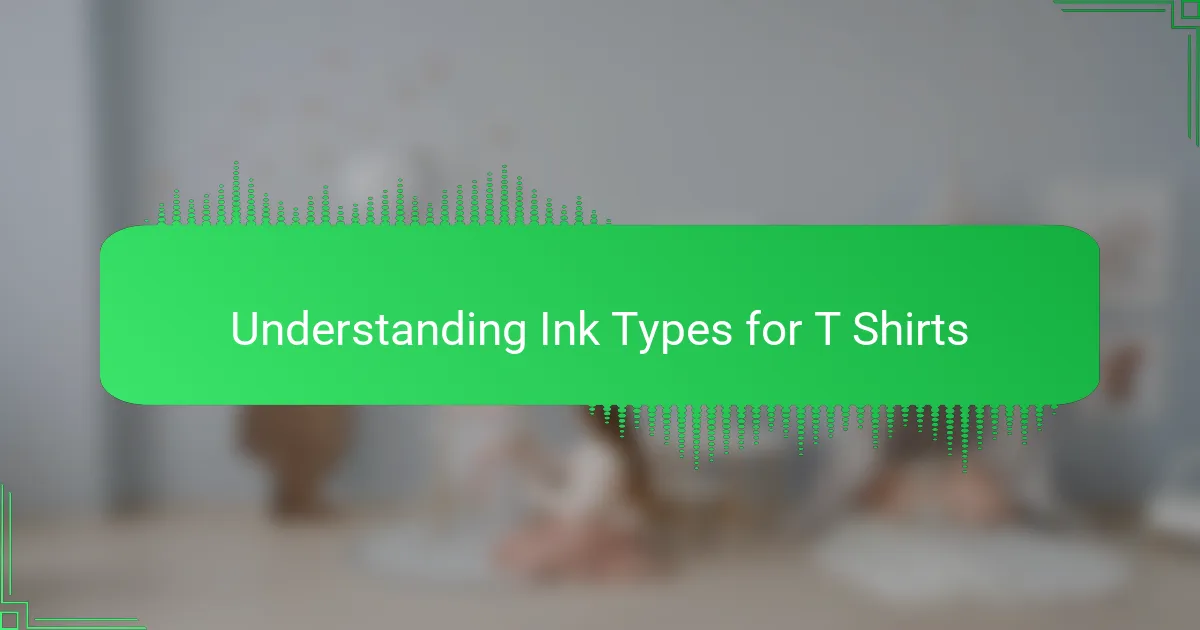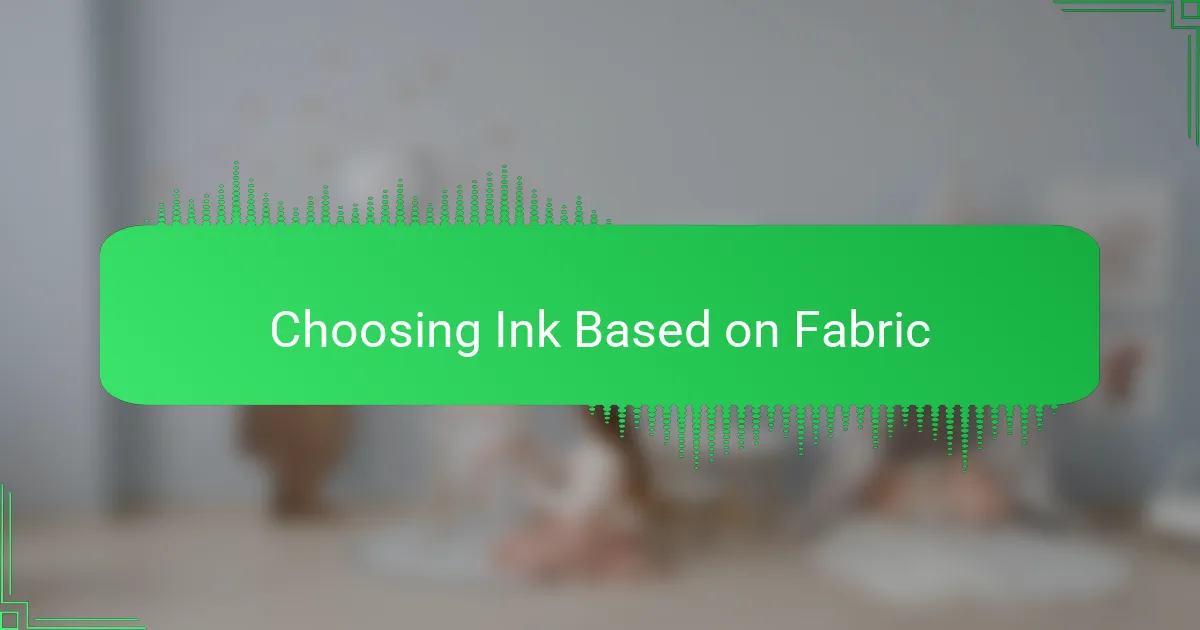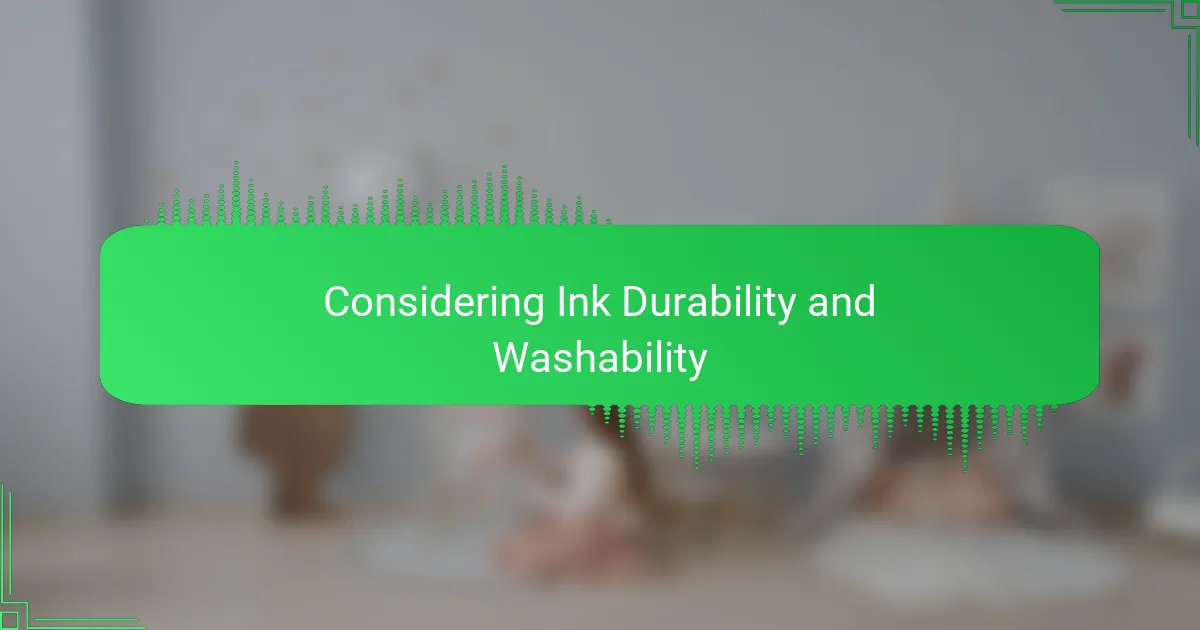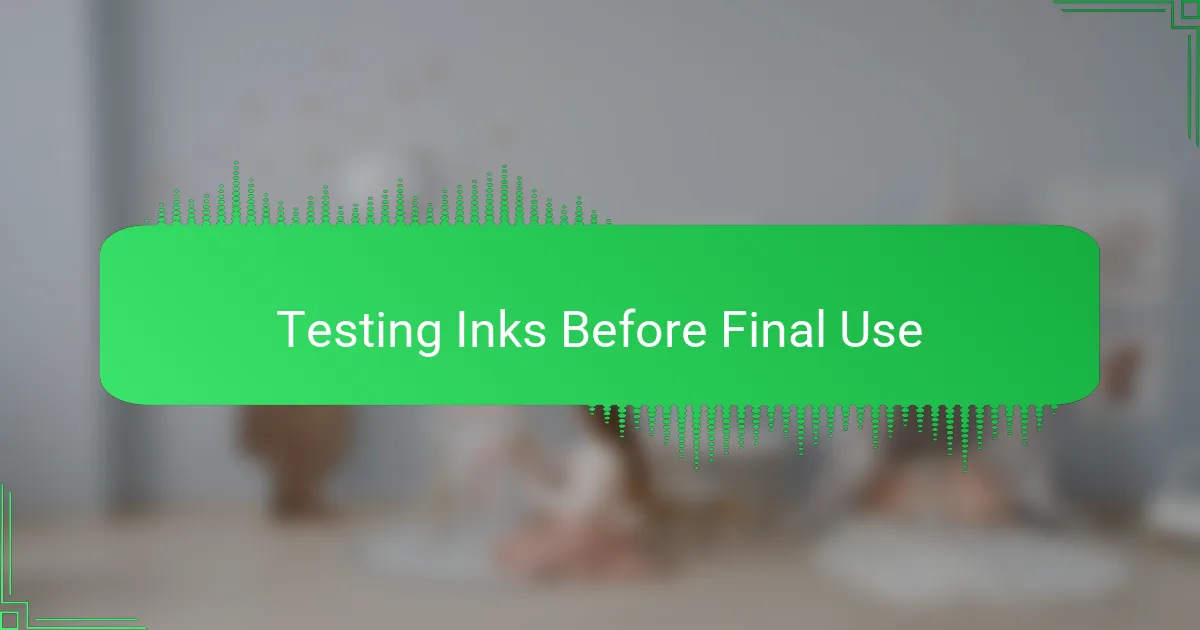Key takeaways
- Understanding different ink types (Plastisol, Water-Based, Discharge, Screen Print, DTG) is crucial for t-shirt design longevity and feel.
- Fabric compatibility is essential; natural fibers work best with water-based or discharge inks, while synthetic fabrics favor Plastisol.
- Durability and washability of ink should be evaluated based on the intended use, with careful consideration of washing conditions influencing ink choice.
- Color selection impacts design impact, with vibrant colors for energy and pastels for calm; testing inks beforehand ensures desired results and client satisfaction.

Understanding Ink Types for T Shirts
When I first started designing t-shirts, I quickly realized that not all inks are created equal. Understanding the types of inks available is crucial because it affects not only the look but also the feel and durability of the final product. I’ve learned that choosing the right ink can make a huge difference in how much people enjoy wearing the t-shirt and how long the design lasts after countless washes.
| Ink Type | Characteristics |
|---|---|
| Plastisol | Thick, vibrant colors; sits on top of fabric; great durability but can feel heavy |
| Water-Based | Soft feel; soaks into fabric; eco-friendly but can fade faster |
| Discharge | Removes dye to create a vintage look; very soft; requires precise fabric type |
| Screen Print | Traditional method; versatile; excellent for bulk printing with vivid colors |
| DTG (Direct to Garment) | High detail; ideal for small runs; softer feel but less vibrant on dark fabrics |

Evaluating Project Requirements
When I evaluate the project requirements, the first thing I ask myself is: What’s the intended use of these t-shirts? For example, if I’m designing for an event where durability is key, I lean toward inks like Plastisol because they hold up well through many washes. It’s all about matching the ink’s strengths with the needs of the project.
Sometimes clients want that vintage, soft look that feels worn in right from the first wear. In those cases, I consider discharge inks, but only if the fabric is exactly right. I’ve learned the hard way that the wrong fabric can sabotage the whole effect, so understanding fabric compatibility becomes a non-negotiable part of my decision-making.
Then there’s the question of quantity and budget. For large bulk orders, it makes sense to choose screen printing for efficiency and color vibrancy, but when it’s a small, detailed run, I find myself reaching for DTG printing. How do you balance cost, detail, and feel? I find this balancing act to be one of the most exciting parts of the whole creative process.

Choosing Ink Based on Fabric
Fabric choice has always been my starting point when picking inks. For example, natural fibers like cotton really shine with water-based or discharge inks since they absorb the ink well, resulting in soft, breathable designs. I’ve tried using discharge ink on polyester blends before, and it just didn’t “take” properly — the colors came out dull and patchy, which was frustrating.
Have you ever noticed how plastisol ink sits like a little raised layer on the fabric? I tend to save plastisol for synthetic fabrics or mixed blends where water-based inks don’t soak in as easily. It’s heavier but holds color vibrancy no matter how tough the washing machine gets, which is a huge relief when durability is a priority.
Sometimes, I ask myself: am I okay with my ink bonding to the fabric’s surface or should it soak in? That question helps me decide between plastisol and water-based in a heartbeat. Texture, feel, and how the fabric reacts are all critical — because at the end of the day, you want your design to feel as good as it looks.

Considering Ink Durability and Washability
When it comes to durability and washability, I’ve found that this is where the true test of ink quality shows up. I remember a client who ran a fitness camp; their shirts went through rigorous washes. Plastisol was my go-to choice because it doesn’t crack or fade easily, and their feedback about the longevity was fantastic. Have you ever had a t-shirt design peel off after a few washes? That’s the kind of disappointment I want to avoid at all costs.
I’ve also learned that washability isn’t just about surviving the detergent but keeping the vibrancy intact. Some water-based inks, while beautifully soft, tend to fade faster, which can be heartbreaking when you’ve poured your creativity into every detail. It makes me wonder: is a soft feel worth the trade-off if the colors start dulling after just a couple of washes? For me, it depends on the project, but I always stress-test samples beforehand to make sure the result lasts.
One trick I’ve picked up over time is factoring in how the shirt will be washed. Are these tees going to be tossed in a machine with hot water and strong detergents, or handled gently? This small question often sways my ink choice dramatically. It’s a detail that many tend to overlook but, from experience, it’s a game-changer for keeping designs looking fresh and wearable over time.

Selecting Colors for Design Impact
Selecting the right colors is crucial to making your t-shirt design stand out. I’ve found that vibrant inks catch the eye quickly, but subtle tones can convey sophistication and emotion. It really depends on the message I want the shirt to express—bold colors for energy, pastels for calmness.
| Color Type | Design Impact |
|---|---|
| Vibrant | Grabs attention, creates excitement, perfect for bold statements |
| Pastel | Soft and soothing, evokes comfort and subtlety |
| Neutrals | Timeless and versatile, can balance bright colors or stand alone for minimalism |
| Metallic | Adds a premium feel, great for luxury or celebratory themes |

Testing Inks Before Final Use
Testing inks before final use is crucial in t-shirt design because it reveals how the ink behaves on different fabrics and under various conditions. I always print small swatches to check color vibrancy, drying time, and wash resistance. This step saves me from costly mistakes and ensures the final product lives up to my standards.
| Ink Type | Tested Properties |
|---|---|
| Plastisol | Vibrant colors, good opacity, longer drying time |
| Water-Based | Softer feel, less vibrant, faster drying |
| Discharge | Removes fabric dye, very soft finish, requires fabric compatibility check |

My Personal Ink Selection Process
My Personal Ink Selection Process hinges on balancing durability with vibrant color payoff. Over the years, I’ve learned that not all inks are created equal—some might look great at first but fade quickly, which is a dealbreaker for me. I always test inks on similar fabric types to the final product; this way, I avoid surprises and keep client satisfaction high.
| Ink Type | My Experience |
|---|---|
| Plastisol Ink | Highly durable and vibrant, but can feel heavy on fabric. I prefer it for bold designs that need to last. |
| Water-Based Ink | Feels softer and more breathable, which my clients love. It requires more care in washing, so I always inform customers about that. |
| Discharge Ink | Creates a soft print by removing fabric dye, which I find visually stunning but tricky to master. It’s my go-to for vintage looks. |
